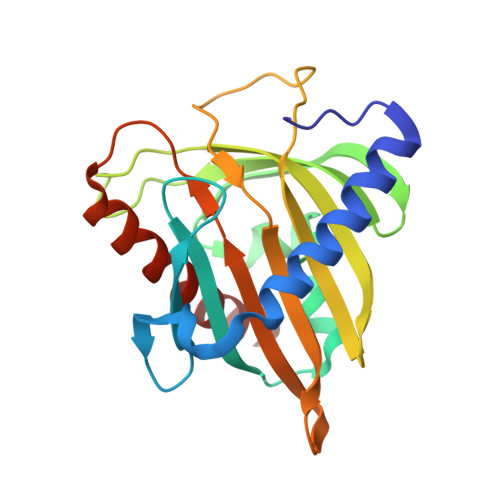STARD4 Membrane Interactions and Sterol Binding.
Iaea, D.B., Dikiy, I., Kiburu, I., Eliezer, D., Maxfield, F.R.(2015) Biochemistry 54: 4623-4636
- PubMed: 26168008
- DOI: https://doi.org/10.1021/acs.biochem.5b00618
- Primary Citation of Related Structures:
5BRL - PubMed Abstract:
The steroidogenic acute regulatory protein-related lipid transfer (START) domain family is defined by a conserved 210-amino acid sequence that folds into an α/β helix-grip structure. Members of this protein family bind a variety of ligands, including cholesterol, phospholipids, sphingolipids, and bile acids, with putative roles in nonvesicular lipid transport, metabolism, and cell signaling. Among the soluble START proteins, STARD4 is expressed in most tissues and has previously been shown to transfer sterol, but the molecular mechanisms of membrane interaction and sterol binding remain unclear. In this work, we use biochemical techniques to characterize regions of STARD4 and determine their role in membrane interaction and sterol binding. Our results show that STARD4 interacts with anionic membranes through a surface-exposed basic patch and that introducing a mutation (L124D) into the Omega-1 (Ω1) loop, which covers the sterol binding pocket, attenuates sterol transfer activity. To gain insight into the attenuating mechanism of the L124D mutation, we conducted structural and biophysical studies of wild-type and L124D STARD4. These studies show that the L124D mutation reduces the conformational flexibility of the protein, resulting in a diminished level of membrane interaction and sterol transfer. These studies also reveal that the C-terminal α-helix, and not the Ω1 loop, partitions into the membrane bilayer. On the basis of these observations, we propose a model of STARD4 membrane interaction and sterol binding and release that requires dynamic movement of both the Ω1 loop and membrane insertion of the C-terminal α-helix.
Organizational Affiliation:
†Department of Biochemistry, Weill Cornell Medical College, 1300 York Avenue, New York, New York 10065, United States.














